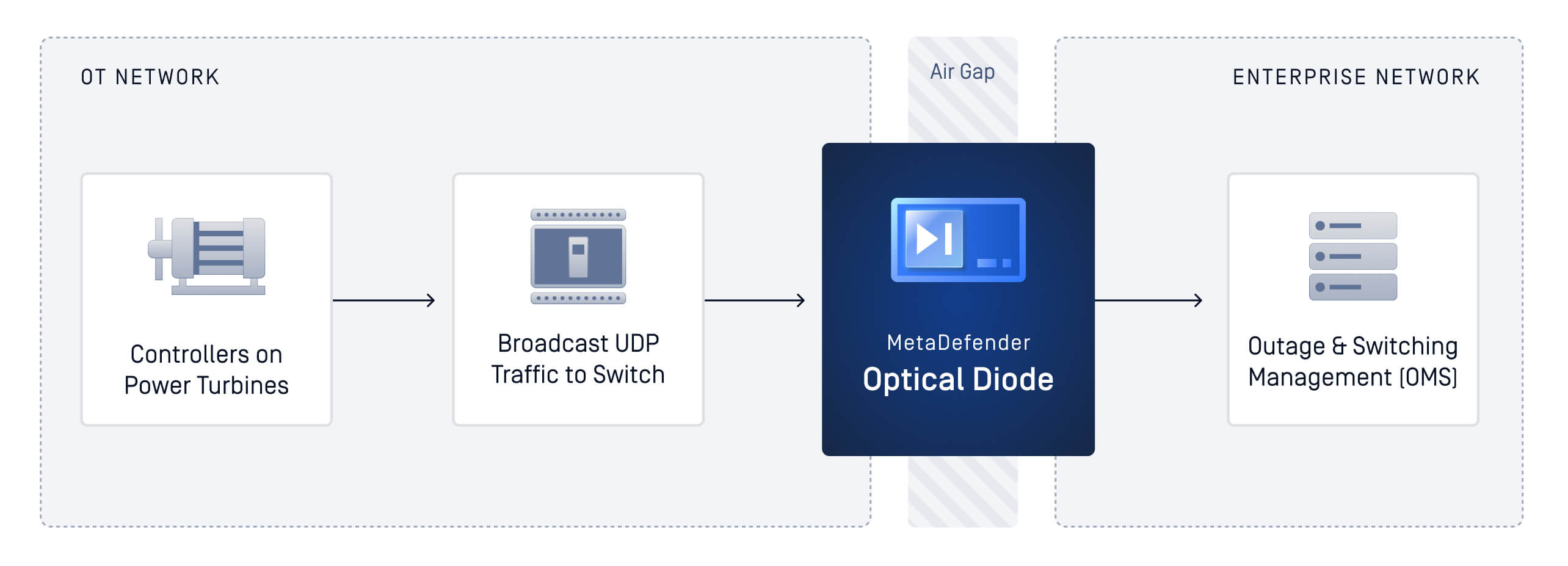Security Barriers in Transmitting Broadcast UDP Data
Power generation facilities require continuous, real-time monitoring to ensure grid stability and optimal performance. This need has become even more critical as cyberattacks on utilities increased 70 percent in 2024, with 1,162 documented cyberattacks on utilities according to Check Point Research. Compounding this challenge, the North American Electric Reliability Corporation has identified that grid vulnerabilities are expanding rapidly, with approximately 60 new susceptible points being added to the electrical grid every single day as utilities integrate new technologies and expand their infrastructure.
For this major electric utility serving 3 million customers across nine states, the turbines transmitted critical operational data via broadcast UDP packets, which were essential for real-time performance monitoring through their Outage & Switching Management system. However, the utility's security firewall was blocking this broadcast UDP traffic as part of standard security protocols. Doing so could leave systems vulnerable to broadcast amplification attacks and decrease network efficiency. Similarly, circumventing the firewall was not an option without a dedicated hardware alternative that could be installed to keep these critical assets secure. Given that power generation facilities are classified as critical infrastructure under federal regulations, maintaining robust cybersecurity posture was non-negotiable.
Traditional solutions would have required extensive equipment upgrades, complex network reconfigurations, or expensive enterprise-grade data diode solutions that could cost tens of thousands of dollars per installation. With multiple turbine sites requiring monitoring, these costs would quickly escalate into the hundreds of thousands.
Turbine Monitoring with a One-Way Data Path
The utility implemented OPSWAT MetaDefender Optical Diode (Fend) as a targeted solution for their turbine monitoring challenge.
By adding OPSWAT optical data diode in their network topology between the site’s central switch and the OSM (Outage & Switching Management) system, broadcast UDP traffic received from each turbine could be securely forwarded to the OSM system in a physically enforced one-way fashion, all without upgrading any of their existing equipment for compatibility.
How It Works

- Turbines forward data to every IP address on the subnet in broadcast UDP mode via a switch
- Input side receives traffic: The input side of the Fend data diode connects to the switch and is configured as a UDP server on the same subnet, receiving the UDP broadcast traffic
- One-way optical isolation: The input side forwards data across the internal one-way optical barrier to the output side of the diode
- Secure delivery to OSM: The output side, acting as a UDP client on the same subnet as the target OSM UDP server, sends UDP traffic directly to the OSM system's IP address
Result: Data reaches its destination, but nothing can travel back into the protected equipment—providing complete unidirectional security.
Industry Best Practice: Defense-in-Depth for Critical Infrastructure
This approach aligns with established cybersecurity frameworks for critical infrastructure protection. The U.S. Department of Homeland Security recommends the use of data diodes for protecting energy infrastructure as part of defense-in-depth strategies. In some sectors, like nuclear energy, data diodes are required by the Nuclear Regulatory Commission.
OPSWAT MetaDefender Optical Diode (Fend) provides an easy-to-deploy and cost-effective way to both comply with regulatory requirements and improve security posture—making it accessible for utilities of all sizes.
Secure, Real-Time Access to Turbine Data
Today, the utility receives operational data from turbines in real time without compromising security from remote threat vectors. The physically enforced one-way data flow ensures that even if the OSM system were compromised, attackers could not reach back into the operational technology environment.
Key Benefits
Cost-Effective Scaling
OPSWAT optical data diodes cost only a fraction of traditional data diode offerings, making multi-site deployment economically viable
Easy Deployment
Compact design fits easily in any equipment cabinet with simple configuration and minimal maintenance requirements
No Equipment Upgrades
Worked seamlessly with existing infrastructure without requiring turbine or switch modifications
Reliable Protection
Hardware-enforced unidirectional data flow provides security guarantees that software solutions cannot match
Scalable Modernization of the Grid
With the successful implementation of OPSWAT MetaDefender Optical Diode (Fend) at their turbine monitoring sites, the utility has established a proven model for securing operational technology data flows. As they continue to modernize their grid infrastructure and integrate new monitoring capabilities, they now have a scalable, affordable solution that doesn't force them to choose between operational visibility and cybersecurity.
Secure Your Critical Infrastructure Without Compromise
Is your organization facing similar challenges with OT data visibility and security? OPSWAT MetaDefender Optical Diode provides hardware-enforced, unidirectional data transfer that protects critical infrastructure while maintaining the real-time operational insights you need.





